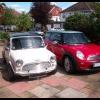Martin's post here has also reminded me that at the end of the day, those making the decisions at BMC / Leyland / Rover were not car enthusiast like most of us here. They were running a business and that meant, it had to make money (though, I think for more of it's life, it didn't !). Updated engine designs aren't what sell cars, especially say with the Mini where largely it appeared very much the same in 2000 as it did in 1959. What sells cars is body styling changes or a compete fresh model altogether, and these days, all the trinkets they can dream up to distract us from the task of driving, while we sit in the traffic with everyone else.
I get management's thinking, it takes years to develop a better engine that those already rolling down the line and zillions in cost to do that. Is it going to result in a 20% or more increase in sales ? Or, they could spend a tiny fraction of that on a change in paint colour, add strips, different trim and maybe even a radio cassette player, all of which takes a small committee an afternoon over a few cups of tea to come up with resulting in an increase sales by 30%.
While that all sounds like it makes sense from a profit view point, clearly, the Japanese showed the world that doing total vehicle updates does in fact pay dividends. Even then, it seems most manufacturers keep their basic engine designs in production for around 10 - 12 years before coming out with the next.
I have to also say, from my own experience, the A Series I don't find unreliable. Sitting here, thinking back over my past 40 something years of ownership and zillions of miles with them, I personally have never had one ever let me down. Yes, they may have developed oil leaks or may have gotten noisy, but they all got me home every time.
Also, in terms of performance, when you break down just about any engine, under the cylinder head, they are all fundamentally similar. There's little difference in the bottom end of our A Series Engines to the Datsun 1200. Certain, as we have all seen, none of the parts in the bottom end of the A Series have any weaknesses and can take a lot more power than as produced. This also highlights where the restriction is in getting decent performance from the A Series.
























